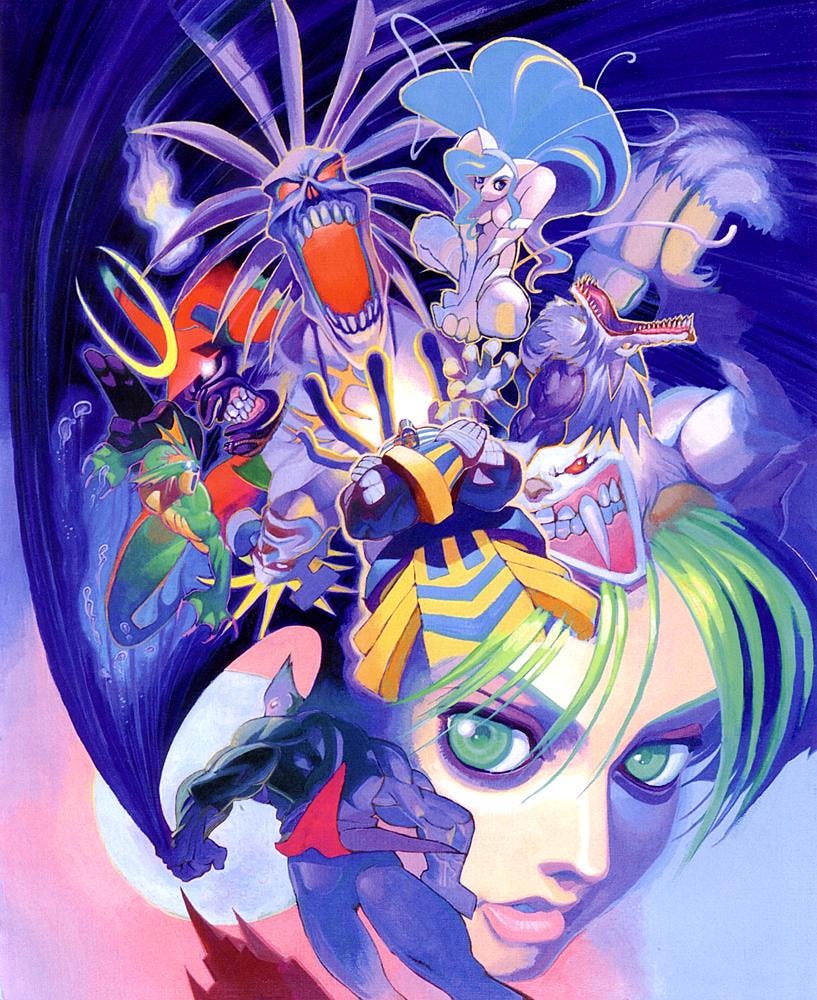
When Nintendo announced plans to bring the entire Marvel vs. Capcom series to the Switch back in June, fans of the cartoonish arcade fighting games were quick to celebrate. But for a smaller subset of MvC fans, the reveal gave them an excuse to dredge up one of the weirdest ‘ships in video-game history: Spider-Man and Morrigan.
While you almost certainly know Spider-Man, there’s a good chance you’ve never heard of the battle-ready succubus Morrigan or the game she comes from: Capcom’s supremely underrated Darkstalkers: The Night Warriors. But 30 years after its release on July 12, 1994, it’s worth celebrating Darkstalkers as an unsung hero that pushed the entire fight game genre forward.

In 1994, Capcom was already well on the way to its current reputation as king of fighting games. The Street Fighter series had proven to be a hit among both general audiences and fighting game fanatics, with Street Fighter II becoming one of the most widely renowned games in history. The company was eager to come up with even more ways for people to grab a joystick and beat each other up. And so a brainstorming session led to the eureka moment that maybe monsters would be fun.
Initially, the idea was to mostly focus on “yokai,” a broad term that encompasses many types of monsters, ghosts, and creatures from Japanese folklore and mythology. According to the game’s planner, Junichi Ohno, that aim shifted to a broader global level, with the monsters eventually covering numerous international archetypes. The denizens of the game that became Darkstalkers: The Night Warriors would include the aforementioned Morrigan, the pharaoh Anakaris, the haunted samurai Bishamon, the catgirl Felicia, the werewolf Jon Talbain, the merman Rikuo, the vampire Demitri, and even a Frankenstein knockoff named Victor.
But that’s just one side of the story. Former producer at Capcom USA, Alex Jimenez, has said the idea spawned from a desire to test a new fighting game engine with characters from the classic Universal Monster catalog. Considering that those films include Frankenstein, Dracula, The Mummy, The Wolfman and even a kind of “merman” in The Creature From The Black Lagoon, it’s not ridiculous to think that an inability to be granted some movie monster licenses would result in various remixes of them. It also allowed for characters outside the typical realm, like Morrigan. Jiminez had to explain what a “succubus” was to the Japanese team, and only when they understood that she was essentially a “female demon that kills men by screwing them to death” did they get excited.

Regardless of how Darkstalkers came to be, the results are evident onscreen. One aspect that shines is the animation. According to producer Noritaka Funamizu, a change in “coloring workflow” created the chance to add more frames to the animation of the characters. It made for sprites that look absolutely beautiful in motion, and ones that rarely move in the choppier style that had been the norm in Street Fighter II. Considering how many little details each character has and how they all bear very distinct designs, this visual upgrade went a long way in establishing a fighting game that was unlike any of its peers.
Darkstalkers’ uniqueness didn’t exactly lend itself to all-encompassing popularity. According to the Japanese video game magazine Gamest, Vampire: The Night Warriors (as it’s known in Japan) only scored fourth place in arcade sales for 1994. The first place winner? Super Street Fighter II Turbo, the fifth (!) iteration of Street Fighter II. But even if Darkstalkers didn’t immediately take over the world, its fans latched on to certain aspects, particularly Morrigan. When it came time to create the grand crossover fighter, Marvel vs Capcom: Clash of Super Heroes, Morrigan was the first of the Darkstalkers crew to be included. To date, she’s appeared in more games outside of the Darkstalkers series than there are actual Darkstalkers games. She also remains a recurring fixture of the cosplay community.

Though the series remains relatively limited (every Darkstalkers game made after 1997 is either an upgraded model of a pre-existing game or a remaster,) it’s branched out into a surprisingly large franchise. In 1997, director Masashi Ikeda went on to helm Night Warriors: Darkstalkers’ Revenge, a four episode anime series that retains all of the fun and moodiness of the source material. Produced by Madouse (the studio behind masterpieces like Perfect Blue, Hunter x Hunter and the recent Frieren: Beyond Journey’s End) it has gorgeous animation befitting the leaps forward that the games previously made.
And when you add on an underwhelming American cartoon, an intriguing Canadian comic book series, and a manga, you end up with something that went way beyond being just “Street Fighter but with vampires.” Darkstalkers: The Night Warriors will likely never be a household name, and most of its modern notoriety comes from characters appearing in other games. But it remains an inspired spin on a genre that all too often relies on redundancy. And being a monster-filled cult classic with a breakout character as globally beloved as Morrigan? There are far worse fates for an arcade game.







